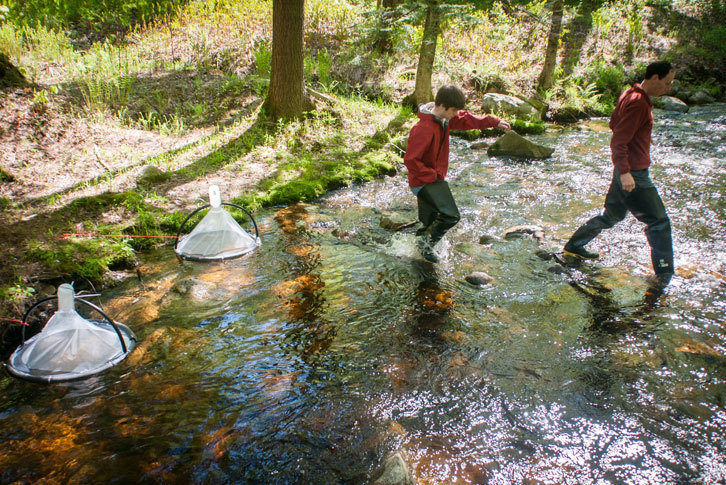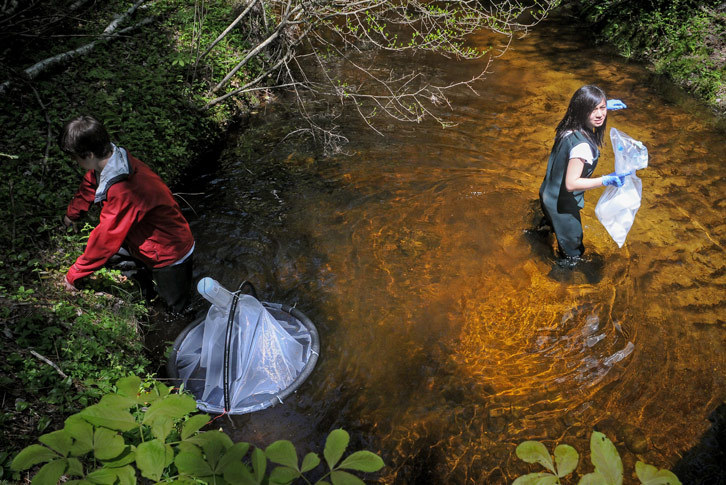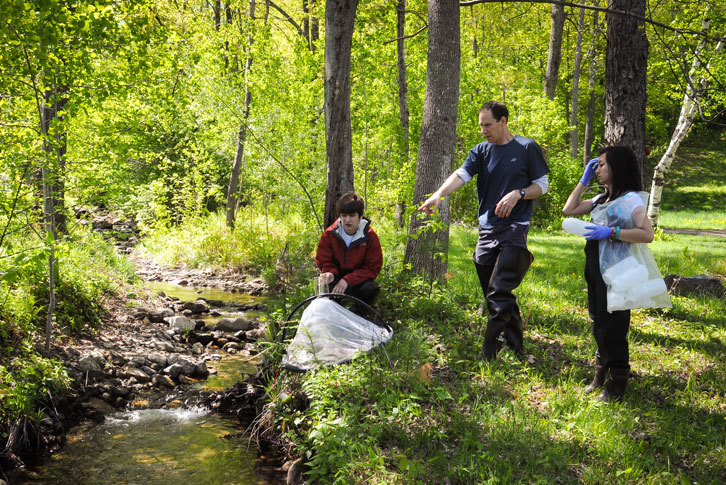Paul Boynton '15 and Jenisha Shrestha '15 spent summer days dressed in waders and boots, tromping through the streams that flow gently into New Hampshire's Lake Sunapee collecting water, aquatic invertebrates and fish — making for the most extraordinary learning experiences of their lives.
It was all part of a radical change at Colby-Sawyer that began in fall 2010, when the National Institutes of Health awarded grants to ten colleges in the state to create a biomedical research network. Known as the New Hampshire Idea Network of Biological Research Excellence (NH-INBRE), the program is led by the state's two research institutions, Dartmouth College and the University of New Hampshire, in collaboration with eight undergraduate institutions, including Colby-Sawyer.
Led by Associate Professor of Natural Sciences Nicholas “Nick” Baer, the students' NH-INBRE sponsored internship focused on the roles ecological, chemical and landscape factors play in determining how mercury accumulates in invertebrates and fish — and the extent to which this toxic metal moves through them and into the region's food webs. Westerly winds carry mercury, a byproduct of coal-burning plants in the Midwest, to the Northeast, Professor Baer explains, where it can contaminate watersheds and pose serious health risks to wildlife and people.

Following training with Professor Baer, Boynton and Shrestha worked with a team of students from other colleges to build 50 traps made of plastic piping and fine mesh. Boynton and Shrestha deployed the traps in 10 tributaries and began the arduous work of collecting aquatic invertebrates, insects born in water as larvae that emerge into the air and on land as adults. They often spent 16-hour days collecting some 77,000 insects over the summer.
The process became easier as other researchers joined the project, which intersects with several others that involve faculty and student researchers from Bates, Dartmouth, Lewis and Clark Colleges, SUNY New Paltz, and the Cary Institute of Ecosystem Studies. The research teams shared samples and data, a collaboration which has created a dynamic environment for teaching and learning.
“Nick wants us to do our work in a meticulous way because our samples will be used for a lot of studies,” says Shrestha. “We have to be careful not to make mistakes.” Shrestha and Boynton's internships focused on the potential transport of mercury from aquatic to terrestrial ecosystems. “We collected invertebrates emerging from the streams and fish from Lake Sunapee. This fall we're identifying, counting, freezing and storing our samples until metal analyses can be conducted.”
An environmental studies major, Shrestha learned to identify most invertebrates by their scientific and common names and created a visual key with their images and characteristics, which she shares with other student researchers. She and Boynton also learned to test the chemistry of water, and to fish and conduct lab analyses of their samples, yet some of their most rewarding experiences came through daily interactions with people on their research team.

“We were a diverse group —biology, chemistry, environmental studies and science majors—working together for four months,” Shrestha says. “It was interesting to share what we knew, teach others and learn in the same process. One of the good things was all the connections I made with the Lake Sunapee Protective Association and the scientists from Dartmouth and other colleges. The experience inspired me.”
A native of Nepal, Shrestha hopes to return one day to work in her country. She communicates with her family via Skype every few weeks and they are beginning to accept her career direction. “Medicine, engineering and business careers are the most popular in Nepal,” she says, “but they are starting to understand what I do here.”
Shrestha has worked closely with Ramsa Chavez- Ulloa, a Ph.D. candidate at Dartmouth College, in a laboratory on identifying and storing invertebrates. “I get a lot of inspiration from Ramsa, who is doing a study here and a similar one in her native Costa Rica. I think about doing something similar in Nepal, which is rich in water resources.”
Boynton grew up in a military family that moved often, and for college, he gravitated to New Hampshire. “I've always liked being outside and in nature, and I really like to learn. Last summer I couldn't believe I was getting paid to walk though New Hampshire streams and do all this awesome stuff. During my internship I thought, 'This is what I love to do, so I must be in the right place.'”
His internship has given him an appreciation for how much work goes into each data point on a graph. “I've learned a lot in my classes, but there's no substitute for handson work in the field. It was interesting to have so many perspectives on everything we were doing— from people my age, Ph.D. students and professors,” Boynton says. “I learned a lot about group dynamics. I was pretty good at it, which is important in science because you need to get along and work with other people.”

The project kept evolving— from water chemistry and insects, to fish and community service, to intense laboratory work— and it all intrigued him. Boynton learned the importance of being patient, organized and meticulous. The experience of working around smart, highly motivated people who love what they do inspired Boynton and lifted his expectations of himself.
“You learn a lot from their experiences and gain some of their wisdom,” he said. “I talked to Nick so much, and not just about the research. You're not just a number and people give you personal advice. It was cool to have a project that wasn't related to a grade and wasn't limited by a class period—and that might connect to what I do later on in my career.”
Professor Baer says that working with students and colleagues on this research has been one of the highlights of his academic career.
“Our collaborative research project benefits the students and the overall research effort. The students are an integral part of most aspects of our research. Many hands make the enormous task of collecting, processing, data management, analyses and dissemination possible for us,” he explains. “Our student research assistants have become part of our research community and are mentored not only by me, but also by the project's co-principal investigator at Dartmouth College, Celia Chen, her research technician, Hannah Roebuck, a Ph.D. student Ramsa Ulloa- Chaves, and many other collaborators. Clearly our students' skills, dedication, attention to detail and strong work ethics will serve them well in their future career paths or graduate school.”
Chen, a ecotoxicology researcher and Professor Baer's project mentor, has been inspired by how her colleague incorporates students like Boynton and Shrestha into so many aspects of his teaching and research. She describes Baer as an “enthusiastic, can-do kind of scientist who is an absolute pleasure to work with.”

Chen, a ecotoxicology researcher and Professor Baer's project mentor, has been inspired by how her colleague incorporates students like Boynton and Shrestha into so many aspects of his teaching and research. She describes Baer as an “enthusiastic, can-do kind of scientist who is an absolute pleasure to work with.”
“Nick has a spontaneous but organized style of working with his students and collaborators. The Colby-Sawyer students… are all very dedicated and extremely hard working,” Professor Chen says. “They have been very responsible and committed.”